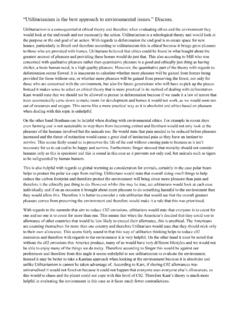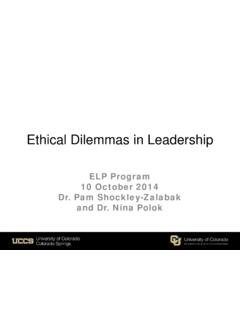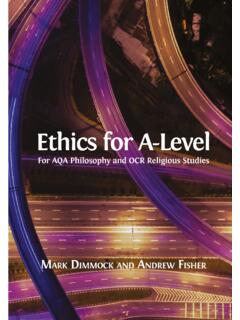Transcription of Resolving an Ethical Dilemma - Welcome to Bourbon
1 1 Resolving an Ethical DilemmaThomas I. White, / document is in PDF format and can be found at more detail on this topic, go to page you ve got an Ethical Dilemma on your hands. How do you figure out what to do? Generallyspeaking, there are two major approaches that philosophers use in handling Ethical dilemmas. One approachfocuses on the practical consequences of what we do; the other concentrates on the actions themselves. Thefirst school of thought basically argues "no harm, no foul"; the second claims that some actions are simplywrong. Thinkers have debated the relative merits of these approaches for centuries, but for the purpose ofgetting help with handling Ethical dilemmas, think of them as complementary strategies for analyzing andresolving problems.
2 Here's a brief, three-step strategy that shows you how to combine them.(By the way, we re going to assume that if there are any laws involved, you plan to obey them. This isn t tosay that it s always morally wrong to break laws. But in Ethical dilemmas that arise in business, the lawsgenerally establish at least a bare minimum for how you should act. Besides, if a business regularly breakslaws, it becomes an anti-social force in society. And no matter how much money s involved, at that point,there s not a huge difference between a business and organized crime.)Step 1: Analyze The , so you re going to stay on this side of the law. What next? It s probably easier to start by looking at theconsequences of the actions you re considering.
3 Assume you have a variety of options. Consider the range ofboth positive and negative consequences connected with each one. Who will be helped by what you do? Who will be hurt? What kind of benefits and harms are we talking about? After all, some "goods" in life (like health) aremore valuable than others (like a new VCR). A small amount of "high quality" good can outweigh alarger amount of "lower quality" good. By the same token, a small amount of "high quality" harm (thepain you produce if you betray someone s trust on a very important matter) can outweigh a largeramount of "lower quality" pain (the disappointment connected with waiting another few months fora promotion). How does all of this look over the long run as well as the short run.
4 And if you re tempted to giveshort shrift to the long run, just remember that you re living with a lot of long-term negativeconsequences (like air and water pollution and the cost of the S&L bailout) that people before youthought weren t important enough to worry looking at all of your options, which one produces the best mix of benefits over harms?Step 2: Analyze The ActionsNow consider all of your options from a completely different perspective. Don t think about theconsequences. Concentrate instead strictly on the actions. How do they measure up against moral principleslike honesty, fairness, equality, respecting the dignity of others, respecting people's rights, and recognizingthe vulnerability of individuals weaker or less fortunate than others?
5 Do any of the actions that you'reconsidering "cross the line," in terms of anything from simple decency to an important Ethical principle? Ifthere's a conflict between principles or between the rights of different people involved, is there a way to seeone principle as more important than the others? What you're looking for is the option whose actions areleast 3: Make A DecisionAnd now, take both parts of your analysis into account and make a strategy should give you at least some basic steps you can more about Philosophical Ethics in the next EthicsAdapted from Thomas White, "Ethics," Chapter 1, Business Ethics: A Philosophical Reader (New York:Macmillan Publishing, document is in PDF format and can be found at Philosophical ethics2.)
6 Teleological (results oriented) ethicsa. Jeremy Bentham: quantifying pleasureb. John Stuart Mill: types of pleasure3. Deontological (act oriented) ethicsa. Immanuel Kant: a universal moral law4. Evaluating the moral character of actions1. Philosophical ethicsEthics is the branch of philosophy that explores the nature of moral virtue and evaluates humanactions. Philosophical ethics differs from legal, religious, cultural and personal approaches to ethics byseeking to conduct the study of morality through a rational, secular outlook that is grounded in notions ofhuman happiness or well-being. A major advantage of a philosophical approach to ethics is that it avoids theauthoritarian basis of law and religion as well as the subjectivity, arbitrariness and irrationality that maycharacterize cultural or totally personal moral views.
7 (Although some thinkers differentiate between "ethics,""morals," " Ethical " and "moral," this discussion will use them synonymously.)Generally speaking, there are two traditions in modern philosophical ethics regarding how todetermine the Ethical character of actions. One argues that actions have no intrinsic Ethical character butacquire their moral status from the consequences that flow from them. The other tradition claims that actionsare inherently right or wrong, , lying, cheating, stealing. The former is called a teleological approach toethics, the latter, Teleological (results oriented) ethicsA teleological outlook is particularly appealing because it takes a pragmatic, common-sense, evenunphilosophical approach to ethics.
8 Simply put, teleological thinkers claim that the moral character ofactions depends on the simple, practical matter of the extent to which actions actually help or hurt that produce more benefits than harm are "right"; those that don't are "wrong." This outlook is bestrepresented by utilitarianism , a school of thought originated by the British thinker Jeremy Bentham (1748-1832) and refined by John Stuart Mill (1806-1873).a. Jeremy Bentham: quantifying pleasureStrongly influenced by the empiricism of David Hume, Jeremy Bentham aimed at developing a"moral science" that was more rational, objective and quantitative than other ways of separating right fromwrong. Bentham particularly argued against the ascetic religious traditions of eighteenth-century Englandthat held up suffering and sacrifice as models of begins with what he takes as the self-evident observations that 1) pleasure and pain governour lives, and 2) the former makes life happier, while the latter makes it worse.
9 These two concepts anchorBentham's Ethical outlook. "Nature has placed mankind," he writes in his Introduction to the Principles ofMorals and Legislation, "under the governance of two sovereign masters, pain and pleasure. It is for themalone to point out what we ought to do, as well as to determine what we shall do. On the one hand thestandard of right and wrong, on the other the chain of causes and effects, are fastened to their throne."From this insight about pleasure and pain, Bentham develops as his Ethical touchstone the notion of"utility": "that property in any object, whereby it tends to produce benefit, advantage, pleasure, good orhappiness, (all this in the present case comes to the same thing) or (what comes again to the same thing) to4prevent the happening of mischief, pain, evil, or unhappiness to the party whose interest is considered: ifthat party be the community in general, then the happiness of the community: if a particular individual, thenthe happiness of that individual.
10 " utilitarianism therefore contends that something is morally good to theextent that it produces a greater balance of pleasure over pain for the largest number of people involved, or,as it is popularly described, "the greatest good of the greatest number." Pleasure is Bentham's ultimatestandard of morality because "the greatest happiness of all those whose interest is in question .. [is] theright and proper, and only right and proper and universally desirable, end of human action."Aiming to make ethics practical, Bentham even proposed a system for measuring the amount ofpleasure and pain that an action produces. Called the hedonistic calculus, Bentham's system identifies sevenaspects of an action's consequence that can be used to compare the results of different deeds: the intrinsicstrength of the pleasurable or painful feelings produced (intensity), how long they last (duration), how likelyit is that these sensations will be produced by a given action (certainty or uncertainty), how soon they will befelt (propinquity or remoteness), whether these feelings will lead to future pleasures (fecundity) or pains(purity), and the number of people affected (extent).







